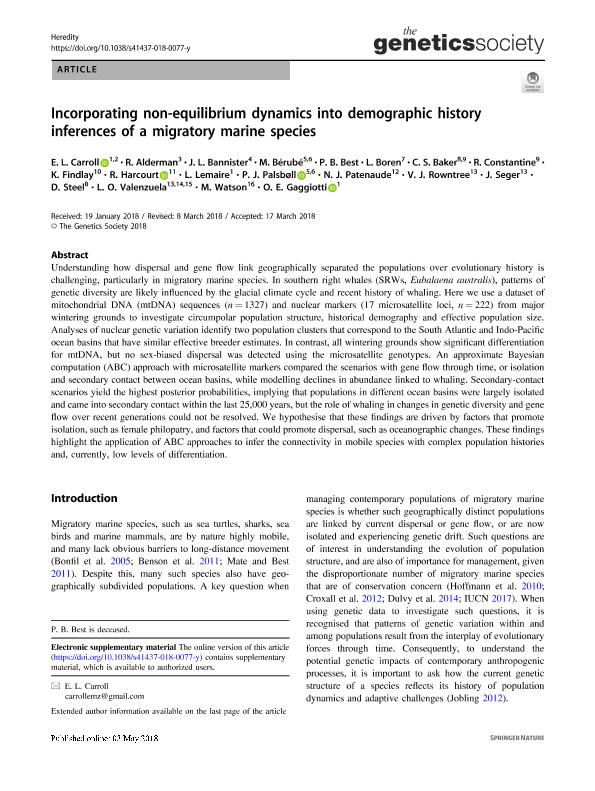Artículo
Incorporating non-equilibrium dynamics into demographic history inferences of a migratory marine species
Carroll, E. L.; Alderman, R.; Bannister, J. L.; Bérubé, M.; Best, P. B.; Boren, L.; Baker, C. S.; Constantine, R.; Findlay, K.; Harcourt, R.; Lemaire, L.; Palsbøll, P. J.; Patenaude, N. J.; Rowntree, V. J.; Seger, J.; Steel, D.; Valenzuela, Luciano Oscar ; Watson, M.; Gaggiotti, O. E.
; Watson, M.; Gaggiotti, O. E.
 ; Watson, M.; Gaggiotti, O. E.
; Watson, M.; Gaggiotti, O. E.
Fecha de publicación:
01/2019
Editorial:
Nature Publishing Group
Revista:
Heredity
ISSN:
0018-067X
Idioma:
Inglés
Tipo de recurso:
Artículo publicado
Clasificación temática:
Resumen
Understanding how dispersal and gene flow link geographically separated the populations over evolutionary history is challenging, particularly in migratory marine species. In southern right whales (SRWs, Eubalaena australis), patterns of genetic diversity are likely influenced by the glacial climate cycle and recent history of whaling. Here we use a dataset of mitochondrial DNA (mtDNA) sequences (n = 1327) and nuclear markers (17 microsatellite loci, n = 222) from major wintering grounds to investigate circumpolar population structure, historical demography and effective population size. Analyses of nuclear genetic variation identify two population clusters that correspond to the South Atlantic and Indo-Pacific ocean basins that have similar effective breeder estimates. In contrast, all wintering grounds show significant differentiation for mtDNA, but no sex-biased dispersal was detected using the microsatellite genotypes. An approximate Bayesian computation (ABC) approach with microsatellite markers compared the scenarios with gene flow through time, or isolation and secondary contact between ocean basins, while modelling declines in abundance linked to whaling. Secondary-contact scenarios yield the highest posterior probabilities, implying that populations in different ocean basins were largely isolated and came into secondary contact within the last 25,000 years, but the role of whaling in changes in genetic diversity and gene flow over recent generations could not be resolved. We hypothesise that these findings are driven by factors that promote isolation, such as female philopatry, and factors that could promote dispersal, such as oceanographic changes. These findings highlight the application of ABC approaches to infer the connectivity in mobile species with complex population histories and, currently, low levels of differentiation.
Archivos asociados
Licencia
Identificadores
Colecciones
Articulos(CCT - TANDIL)
Articulos de CTRO CIENTIFICO TECNOLOGICO CONICET - TANDIL
Articulos de CTRO CIENTIFICO TECNOLOGICO CONICET - TANDIL
Citación
Carroll, E. L.; Alderman, R.; Bannister, J. L.; Bérubé, M.; Best, P. B.; et al.; Incorporating non-equilibrium dynamics into demographic history inferences of a migratory marine species; Nature Publishing Group; Heredity; 122; 1; 1-2019; 53-68
Compartir
Altmétricas



